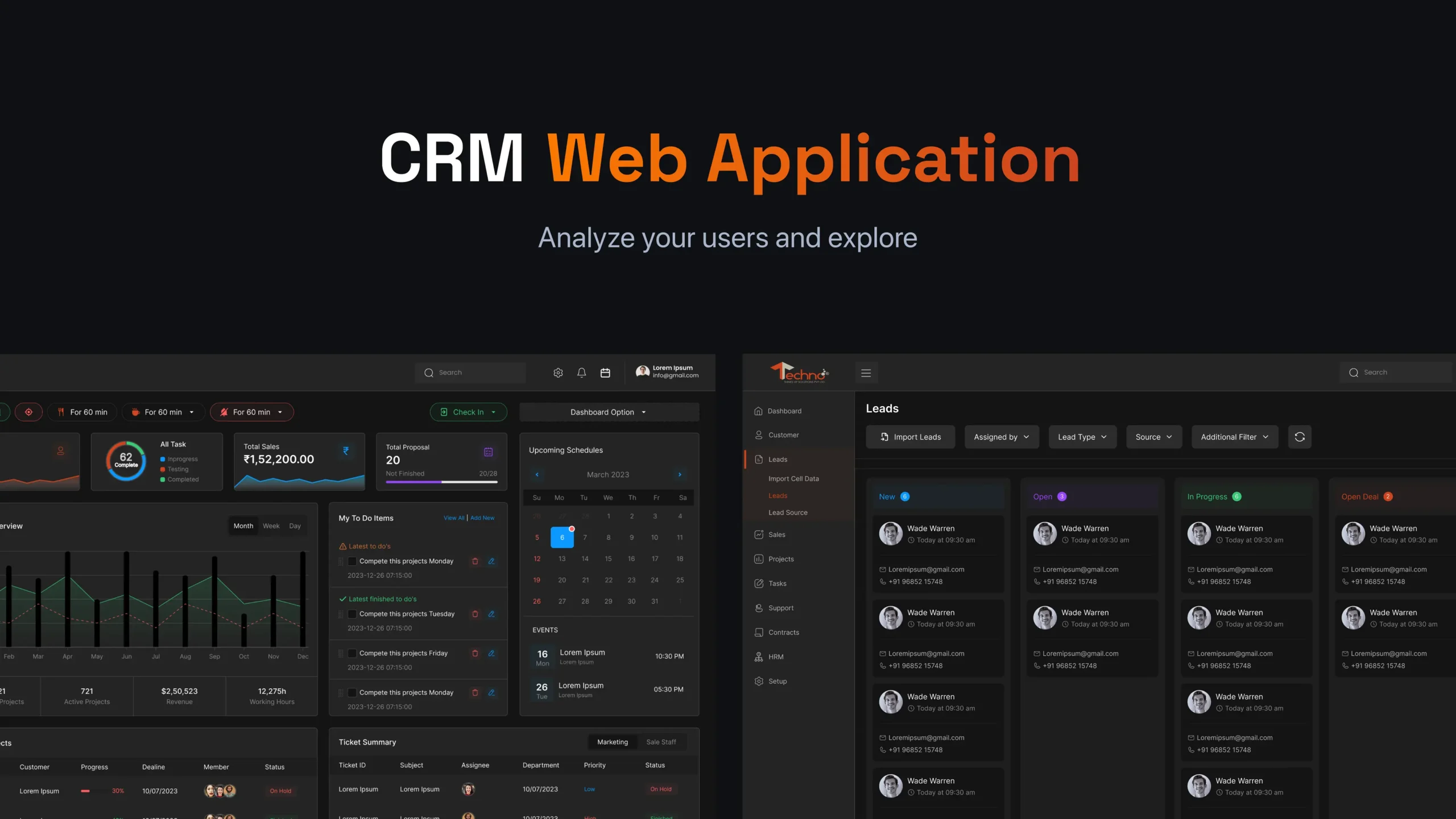
CRM Web Application
Background:
An IT company faced challenges in effectively managing customer relationships, projects, leads, tasks, and employee information. The manual processes and disparate systems were hindering collaboration and efficiency. To address these issues, the company initiated the CRM Web Application project, aiming to develop a comprehensive solution that integrates CRM and project management functionalities. The goal was to enhance customer relationship management, streamline project workflows, and improve overall operational efficiency.
Objective:
The primary objective of the project was to create a CRM Web Application tailored for an IT company, focusing on the following key goals:
- Centralized CRM Management: Developing a centralized system for effective customer relationship management, including leads, opportunities, and client interactions.
- Project Management Integration: Integrating project management functionalities to streamline project workflows, task assignments, and progress tracking.
- Leads Management: Implementing a system to track and manage leads effectively, from initial contact to conversion.
- Task Management: Improving task management processes for enhanced collaboration and productivity.
- Employee Management: Centralizing employee information for efficient HR processes and project team assignments.
Challenges:
Several challenges were identified at the project’s inception:
- Disparate Systems: Managing customer relationships, projects, leads, tasks, and employee information across disparate systems led to data silos and inefficiencies.
- Collaboration Issues: Lack of a centralized platform hindered collaboration among teams, impacting project workflows and communication.
- Data Accuracy: Manual data entry processes led to data inaccuracies, affecting the reliability of customer information and project details.
- User Adoption: Ensuring seamless adoption of the new system by employees required overcoming resistance to change.
Solutions:
To address the challenges, a comprehensive set of solutions was implemented:
- Integrated CRM and Project Management: A unified platform was developed, integrating CRM and project management functionalities for seamless collaboration.
- Automated Data Entry: Automation features were implemented to reduce manual data entry, improving data accuracy and reliability.
- User-Friendly Interface: The application was designed with a user-friendly interface to encourage adoption and facilitate ease of use.
- Training Programs: Training programs were conducted to familiarize employees with the new system, promoting smooth adoption and usage.
Results:
The implementation of the CRM Web Application led to several positive outcomes:
- Improved Collaboration: The integrated platform facilitated better collaboration among teams, improving project workflows and communication.
- Enhanced Data Accuracy: Automated data entry processes reduced errors, improving the accuracy and reliability of customer and project information.
- Streamlined Workflows: The unified system streamlined CRM and project management workflows, leading to increased operational efficiency.
- Positive User Adoption: Training programs and a user-friendly interface contributed to positive user adoption, with employees embracing the new system.
Conclusion:
The CRM Web Application project successfully addressed the challenges faced by the IT company, providing an integrated solution for CRM and project management. The project not only improved operational efficiency but also showcased the transformative impact of technology in enhancing collaboration and customer relationship management. The commitment to seamless integration, automation, and user-friendly design demonstrated the project’s success in meeting its objectives. This case study serves as a testament to the positive outcomes of digital transformation in optimizing processes within the IT sector.




 Web Development
Web Development
 App Development
App Development
 IT Consulation
IT Consulation
 UI/UX Design
UI/UX Design
 Ecommerce
Ecommerce
 Content Marketing
Content Marketing
 DevOps Services
DevOps Services
 Software Development
Software Development
 Digital Marketing
Digital Marketing
 Social Media Marketing
Social Media Marketing
 Search Engine Optimization
Search Engine Optimization
 AWS Managed Services
AWS Managed Services
 QA And Software Testing
QA And Software Testing
 Local Search Optimization
Local Search Optimization
 Technology Outsourcing
Technology Outsourcing
 Metaverse Development
Metaverse Development
 Web 3 Consulting
Web 3 Consulting
 IoT App Development
IoT App Development
 VR App Development
VR App Development
 IT Staff Augmentation
IT Staff Augmentation
 Startup App Development
Startup App Development
 Saas App Development
Saas App Development
 Low Code Development
Low Code Development
 Product Engineering
Services
Product Engineering
Services
 Custom CRM Development
Custom CRM Development
 Offshore Development
Center (ODC)
Offshore Development
Center (ODC)
 Machine Learning
Development
Machine Learning
Development
 Blockchain App Development
Blockchain App Development
 Blockchain In Identity Management
Blockchain In Identity Management
 Artificial Intelligence
Development
Artificial Intelligence
Development
 Dedicated Development Team
Dedicated Development Team
 Strategic Mobile
Consulting
Strategic Mobile
Consulting
 Scrum
Scrum
 DevOps
DevOps
 Lean
Lean
 Kanban
Kanban
 V-Model
V-Model
 Waterfall Model
Waterfall Model
 Design Thinking
Design Thinking
 Agile Development
Agile Development
 Prototype Methodology
Prototype Methodology
 Rapid Application Development (RAD)
Rapid Application Development (RAD)
 Feature-Driven
Development (FDD)
Feature-Driven
Development (FDD)
 Dynamic Systems
Development Method (DSDM)
Dynamic Systems
Development Method (DSDM)





